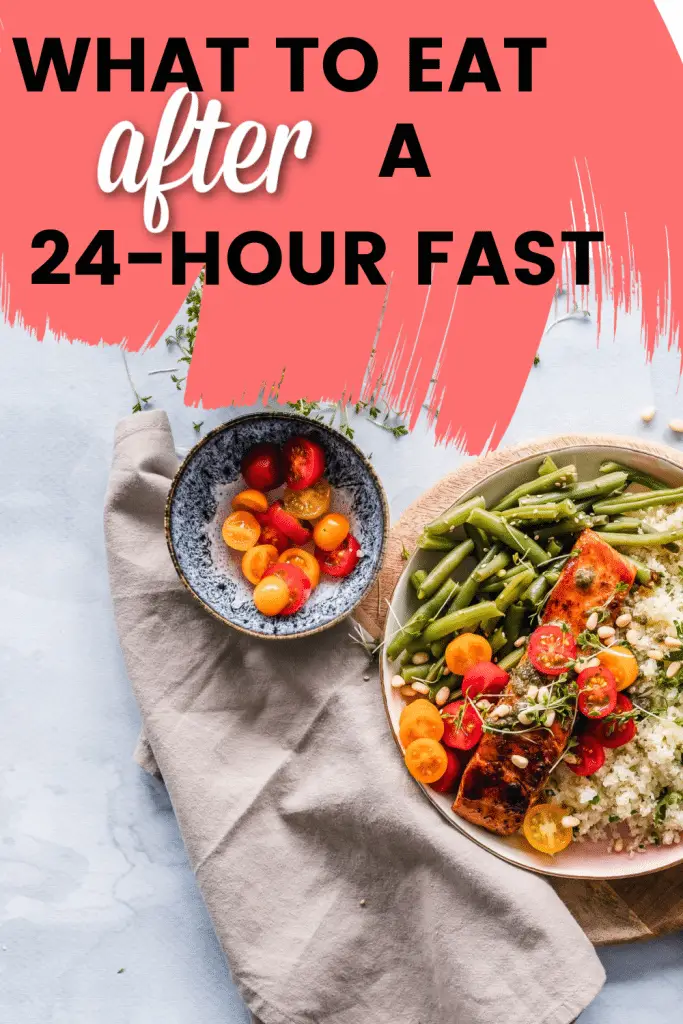People are always wondering what to eat to break a fast. That’s why I wrote What to Eat to Break a Fast (Don’t Sweat the Small Stuff). The guidelines will help you decide what to eat depending on your body and circumstances. However, this post specifically addresses what to eat after a 24-hour fast. We will talk about how 24-hour fasts may help you reach your health goals and what to eat after a 24-hour fast.
Why a 24-Hour Fast
I recommend 24-hour fasts because they:
- are very manageable, even for beginners;
- will get you into a more advanced stage of autophagy;
- help get rid of food cravings when you do them regularly;
- may promote weight loss when your reach a plateau;
- are easy to cycle with other intermittent fasting methods.

24-Hour Fasts for Beginners
Even if you are a beginner, you can do a 24-hour fast. Have a lovely wholesome dinner one night, and stop eating after dinner. The next day, you will be able to eat again, just a bit later than you had your dinner the night before. Even when you are hungry throughout the day, you can look forward to your evening meal, so it is doable. Drink plenty of water, tea, or coffee throughout the day, and enjoy allowing your body to heal. Read What Breaks a Fast and What Doesn’t: An Indispensable Guide for further guidance about what breaks a fast.

What Happens to Your Body When You Fast for 24 Hours
Your body starts using fat cells to produce ketones for energy between 12 and 24 hours after the beginning of your fast. At around the 24-hour mark, you start experiencing some serious autophagy, particularly when it comes to proteins linked to neurodegenerative diseases and your intestinal cells.

How 24-Hour Fasts Help You Overcome a Weight Loss Plateau
Fasting for 24 hours will allow your body to remain in ketosis long enough for you to start noticing a decrease in food cravings over time. Not only that, but it’s a type of fasting that can complement whatever other method you choose. Furthermore, you can use 24-hour fasts to give your body some variety if you are stuck at a weight-loss plateau.
Are You “Stuck”?
Before explaining how to use 24-hour fasts to overcome a weight loss plateau, I would like to quickly remind you that even though you may think you are “stuck” and no longer losing weight, you may not need to do anything about it. Many women worry because they haven’t lost any weight in two weeks. We have to stop agonizing over the scale! Weight loss takes more time than you think. Healing your body takes longer than you think.
It took me a year to lose 20 lbs. There were many months when I did not lose any weight. I kept doing what I was doing because I felt amazing. I could tell my cravings were decreasing, and my energy level was high. On top of that, I was sleeping better than ever.
Before worrying about overcoming a “weight loss plateau,” take note of your other health markers. How are you feeling? Chances are, you need to be more patient with yourself.
Want to use intermittent fasting to conquer your food cravings and biohack weight loss? Check out my Weight Loss Transformation Program.

Using 24-Hour Fasts to Shake Things Up
If you decide to use 24-hour fasts to lose more weight, here’s how you can do it:
- Unless you are doing OMAD (One Meal a Day), you can add one or two 24-hour fasts to your regular intermittent fasting schedule. Say you are fasting 16 hours most days. Keep doing that, but fast for 24 hours, one or two days instead of 16 hours.
- If you are doing OMAD, take a complete break from OMAD. Give your body more variety by fasting for 24 hours twice a week and fewer hours the rest of the week (how many hours will depend on your goals and how you feel).
- You could also try not fasting for more than 12 hours 4 days a week and doing three 24-hour fasts throughout the week. This cycle would be very effective in keeping your body guessing.
Read Top 8 Most Compelling Benefits of a 24-Hour Fast to learn more.

What to Eat After a 24-Hour Fast
Ok, so you decided to start adding 24-hour fasts to your fasting regimen and are wondering what to eat after your 24-hour fast. Here are some of my best tips:
- Pick nutrient-dense foods. Nutrient-dense foods are easy-to-digest foods that are high in vitamins and minerals. My favorite way to break a fast is the Power Shake superfood shake. A nice healthy-fat-rich salad or cooked vegetables are other excellent options.
- Sit down to eat and chew your food well. Take your time, and enjoy the flavors!
- Pick foods you know your body tolerates well. The foods that cause issues after a fast are typically the same foods that don’t serve you the rest of the time either.
- Keep drinking plenty of water.
- Parsley helps with digestion. Mix some fresh chopped parsley into whatever foods you are having if you want.
- Wait half an hour at least before eating a heavier meal.

Fasting for 16 hours most likely won’t impact your digestive function. However, you may be more susceptible to indigestions when breaking longer fasts (24 hours and more).
Signs That You Are Eating the Wrong Foods After a Fast
If you notice the following symptoms, you need to tweak what you are eating after your 24-hour fast:
- Diarrhea or loose stools;
- Presence of undigested foods in stools;
- Abdominal pain;
- Fatigue;
- Bloating.
I always recommend you pay attention to the signs your body sends you; these are pretty clear signs that your body is not appreciating the foods you choose. You may also eat too fast and not chew your food well enough. Consider all the options to improve the situation. Look at my list of nutrient-dense foods and try different combinations. Some people have a hard time digesting raw vegetables. The safest option is usually cooked vegetables. How do you feel after sitting down and taking your time to eat a plate of cooked vegetables? If that works well, add something else and keep experimenting.

Foods to Avoid if You Have Symptoms
As you decide what to eat after a 24-hour fast, keep in mind that the following foods are the most common culprits if you experience symptoms:
- Nuts and seeds
- Raw veggies
- Eggs
- Dairy products
- Alcohol (never break your fast with alcohol)
- Meat
You will most likely be able to consume these foods again a few hours after breaking your fast.

Is Eating Making You Tired?
If fatigue is the main symptom you are experiencing when you break a 24-hour fast, try the following tips:
- Avoid breaking your fast with something that will spike your insulin. Try something low-carb like avocado or low-carb veggies (I have a free downloadable low-carb food list).
- Make sure you stay hydrated during your fast. Try Super Lytes to replenish your electrolytes.
- Consult a qualified health professional if your fatigue doesn’t improve.
In Summary
Choosing what to eat after a 24-hour fast is not a major decision. Fasts under 36 hours will not impact your digestive function much, so it boils down to picking nourishing foods. Break your fast with something small and eat something more consistent about an hour later. You should feel amazing!
Want to learn more about intermittent fasting? Don’t forget to sign up for my Intermittent Fasting 101 Workshop.






